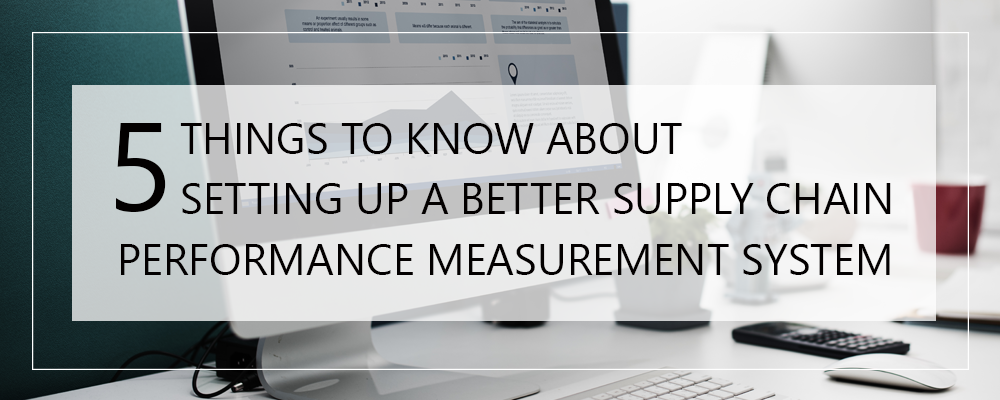“Be proactive, not reactive, for an apparently insignificant issue ignored today can spawn tomorrow’s catastrophe.” – Ken Poirot
Imagine this scenario:
There are two similar companies with equal investments in ERP and supply chain processes. One company is always ahead of its game with continuous proactive actions; while the other regularly struggles with reactive measures.
What’s different?
Their supply chain performance measurement systems.
Many companies focus primarily on monthly reviews of supply chain key performance indicators and tend to take corrective actions only after supply disruptions. To get ahead of the curve and to avoid potential blind spots and pitfalls, a supply chain performance measurement system needs to be dynamic, agile and spontaneous.
So, how do you setup a better system to measure supply chain performance?
Here are 5 things to know about setting up a better supply chain performance measurement system.
1. Definition: What is a supply chain performance measurement system (SCPMS)?
A Supply Chain Performance Management System can be compared to an aircraft’s cockpit, which provides vital signs like altitude, speed, fuel, etc. Similarly, the SCPMS provides information and alerts to supply chain and business managers on key metrics.
SCPMS can be defined as the set of processes and metrics used to quantify both the efficiency and effectiveness of the supply chain. In my upcoming webinar on creating a better supply chain performance monitoring system, I discuss how to use different alerts and notifications to help with managing supply chain performance.
2. Difference between traditional and contemporary SCPMS
Traditionally, a Supply Chain Performance Management System is mostly dependent on a monthly S&OP process and is updated only at predetermined intervals. It tends to be reactive in nature and focuses on damage control after disruptions. Contemporary SCPMS is well designed and customized as per business priorities. It is updated on a daily basis and provides early alerts to supply chain and business managers for facilitating proactive steps to mitigate risks.
[Read more: Is Your Supply Chain Disruptive? Here’s What You Are Missing]3. Supply chain performance management indicators
“Measurement is the first step that leads to control and eventually to improvement. If you can’t measure something, you can’t understand it. If you can’t understand it, you can’t control it. If you can’t control it, you can’t improve it.” – H. James Harrington
There are many supply chain performance indicators that can be tracked on a daily or weekly basis. Here are some examples:
- Actual orders vs. Forecast: The volume of actual confirmed orders received from customers in comparison to the forecasted quantity, provide an indication of the actual market sales trend.
- Actual production vs. Planned: The quantity of actual production in comparison to the finite plan released, provides an insight on the actual production on the shop floor.
- Production rejection in parts per million (PPM): PPM is a measurement of quality performance in which actual rejection figures are converted into rejection per million.
- On-Time In-Full (OTIF) percentage: OTIF measures the logistics delivery performance of dispatching the customer order fully on the committed date.
- Days of Supply (DOS): The on-hand level of finished goods inventory converted in terms of coverage days available against forecasted orders.
- Asset Utilization: Work center utilization as a percentage of total available time.
These are the major supply chain management indicators and they need to be customized and prioritized as per the needs of individual businesses.
4. Importance of supply chain performance measurement
A robust SCPMS is characterized as timely, focused, relevant, dynamic, agile, flexible and spontaneous. It empowers supply chain and business managers with early warning indicators to make timely and high-quality decisions. Timely proactive actions facilitate businesses to re-align their supply chain resources to mitigate financial risks, adjust purchase, production & distribution plans and re-negotiate deliveries with customers. A robust SCPMS is a crucial differentiating factor which provides a competitive advantage to any company in a complex and constantly changing business environment.
[Read more: The 10 Rules of Collaborative Supply Chain Planning]5. Live in action – Practical examples of robust SCPMS
- Premature onset of winter for an ice-cream manufacturer was the early warning indicator for the distribution manager who started keeping a close eye on the customer orders and finished goods DOS. With sustained increased level of DOS, the manufacturer took proactive action to scale back production to bring the DOS back to normal levels.
- A delayed implementation of favorable tax reforms for the automobile sector indicated a delay in an expected spike in sales which was factored into the demand planning process. The supply chain and business managers quickly adjusted their raw material purchase plan and production plan to control the raw material and finished goods DOS back to normal levels.
Irrespective of the type or scale of business, supply chain performance can be efficient and effective if the measurement system is well-designed and customized according to the business requirements and priorities. Continuous monitoring and proactive action on the early warning indicators can save time, efforts and money! Using an ‘always on’ application like the Arkieva Pulse Alerts and Notifications feature helps with continuous monitoring, which in turn leads to proactive problem solving that saves time and money.
Enjoyed this post? Subscribe or follow Arkieva on Linkedin, Twitter, and Facebook for blog updates.







